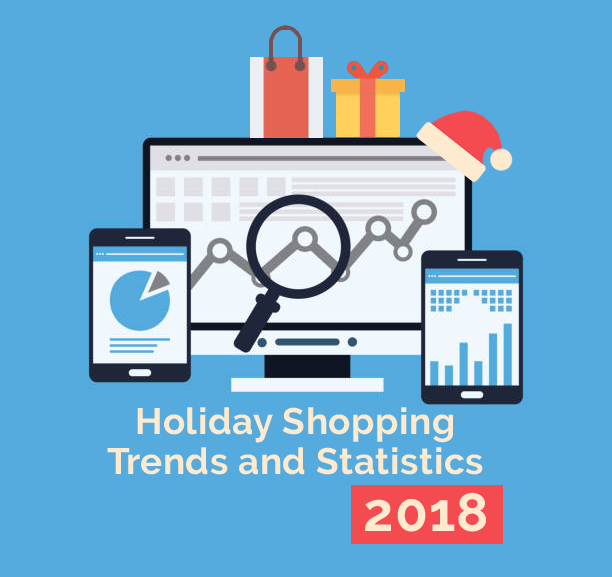Holiday Shopping Trends and Statistics for 2018
It’s never too early for eCommerce store owners to begin gearing up for holiday shopping. And, if you’re like most other savvy online sellers, you’ll want to know exactly what to expect as the season approaches. To help inform your holiday sales strategy, we’ve compiled nine of the most noteworthy holiday shopping trends and statistics for 2018 below.
1. Shoppers Have More Time This Year
Shoppers who wait until Black Friday to begin their holiday shopping will have time on their side this year. The 2018 holiday season gives us the longest possible stretch of time, with the maximum 32 days between Thanksgiving and Christmas. This provides shoppers with ample time to get their shopping done – and to ensure orders arrive in time for the holidays.
2. We’ll See Historically High Growth Rates
Experts suspect that while US retail sales overall are anticipated to climb 4.1%, eCommerce will fare best: for the U.S., eCommerce spending is projected to rise 16.2%, meaning we may see some of the best growth rates in years. This brings projected holiday eCommerce sales to a staggering $123.39 billion, fueled by a favorable macroeconomic climate.
3. Nearly Half of Online Shopping Will Be Mobile
That’s right – you can anticipate nearly half of your sales to come from mobile traffic. Ecommerce will continue to be driven by mobile sales, withroughly 44% of holiday eCommerce spending taking place on smartphones, tablets, and other mobile devices. Clearly, it’s now more important than ever to ensure your store is optimized for a flawless mobile experience.
4. The “Big 3” Will Continue to Reign
As with years past, eCommerce retailers should prepare to see their biggest selling days on Thanksgiving Day, Cyber Monday, and Black Friday. While Thanksgiving saw the highest year-over-year increase in total sales in 2017, Cyber Monday remained the most popular day for making online purchases. Now more than a decade old, Cyber Monday is officially the biggest shopping day of the year. Online transactions for 2017 reached$6.59 billion, making it the largest online shopping day in U.S. history, with a record 81 million people having shopped online on Cyber Monday of 2017. Many retailers are gearing up for this year with last-minute or even real-time deals, as well as promo codes that will be needed to score the best savings.
5. Returns Will Spike Significantly
Unfortunately, that boost in sales will also translate to a higher return rate: Black Friday returns go up by 50% for eCommerce, compared to the rate across the rest of the year. It’s also worth noting that while many U.S.-based shoppers wait until this quintessential shopping holiday to begin their pursuit for gifts, in countries where a November Thanksgiving isn’t celebrated, holiday shopping begins as early as October. Thus, heavy discounting in November could eat into Christmas margins for stores with international customer bases.
6. Black Friday Traffic Peaks in the Evening
While some brick and mortar retailers plan for throngs of people as early as Thanksgiving evening and then again early Friday morning, eCommerce doesn’t get hit quite as hard until much later. It’s 8 pm on Black Friday when sales peak, so time your email marketing strategy wisely. While you’ll certainly want to roll out a sale email early, it might be worthwhile to ping shoppers later in the day, too.
7. Shopping Starts Mid-November…
If you think your shoppers are waiting until Black Friday to begin crossing items off their lists this year, think again. Traffic begins shooting upwards the weekend before, which will fall on Saturday, November 17th this year. After that point, sales will continue to escalate until Christmas. If you haven’t already done so, gain an edge over your competition by refining your strategy so your holiday campaigns start even earlier.
8. Christmas Shopping Peaks on the 26th
After all of the holiday festivities have passed and shoppers have gift cards in hand, the downtime following the Christmas rush creates the perfect scenario for online shopping. Thus, don’t be surprised if your highest traffic day in December falls on the 26th this year!
9. You’ll Need to Gear UP for Cyber Week II
The span of time directly after Christmas until New Year’s Day has become so popular for online shopping that experts have dubbed it “Cyber Week II.” Be sure to leverage this window by deploying strategic marketing tactics before shoppers start buckling down on spending in early 2019.
Is your eCommerce store ready to handle holiday traffic? With shopping anticipated to begin this month, now is the time to optimize your store so that your checkout and overall shopping experience is as seamless and hassle-free as possible.

